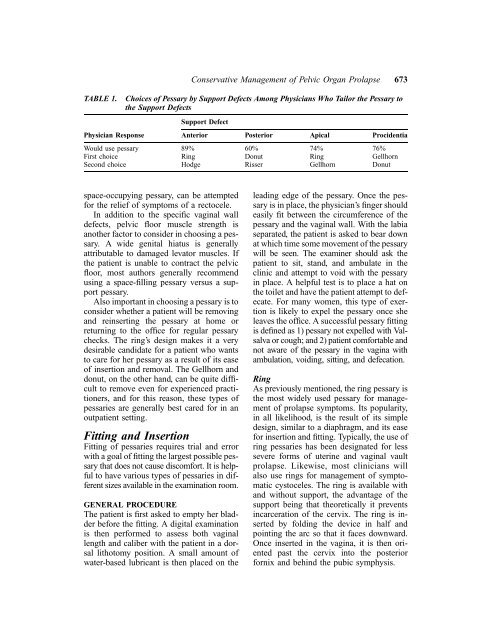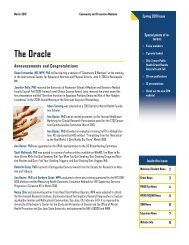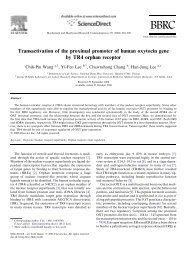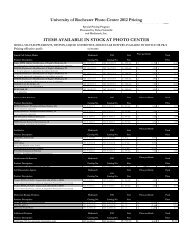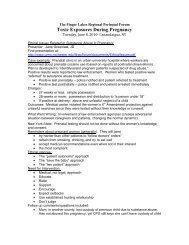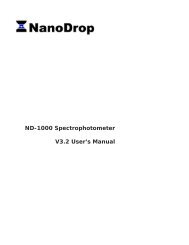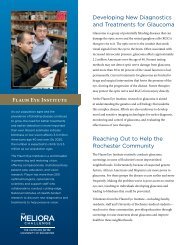Conservative Management of Pelvic Organ Prolapse
Conservative Management of Pelvic Organ Prolapse
Conservative Management of Pelvic Organ Prolapse
Create successful ePaper yourself
Turn your PDF publications into a flip-book with our unique Google optimized e-Paper software.
TABLE 1. Choices <strong>of</strong> Pessary by Support Defects Among Physicians Who Tailor the Pessary to<br />
the Support Defects<br />
Support Defect<br />
Physician Response<br />
Anterior Posterior Apical Procidentia<br />
Would use pessary 89% 60% 74% 76%<br />
First choice Ring Donut Ring Gellhorn<br />
Second choice Hodge Risser Gellhorn Donut<br />
space-occupying pessary, can be attempted<br />
for the relief <strong>of</strong> symptoms <strong>of</strong> a rectocele.<br />
In addition to the specific vaginal wall<br />
defects, pelvic floor muscle strength is<br />
another factor to consider in choosing a pessary.<br />
A wide genital hiatus is generally<br />
attributable to damaged levator muscles. If<br />
the patient is unable to contract the pelvic<br />
floor, most authors generally recommend<br />
using a space-filling pessary versus a support<br />
pessary.<br />
Also important in choosing a pessary is to<br />
consider whether a patient will be removing<br />
and reinserting the pessary at home or<br />
returning to the <strong>of</strong>fice for regular pessary<br />
checks. The ring’s design makes it a very<br />
desirable candidate for a patient who wants<br />
to care for her pessary as a result <strong>of</strong> its ease<br />
<strong>of</strong> insertion and removal. The Gellhorn and<br />
donut, on the other hand, can be quite difficult<br />
to remove even for experienced practitioners,<br />
and for this reason, these types <strong>of</strong><br />
pessaries are generally best cared for in an<br />
outpatient setting.<br />
Fitting and Insertion<br />
Fitting <strong>of</strong> pessaries requires trial and error<br />
with a goal <strong>of</strong> fitting the largest possible pessary<br />
that does not cause discomfort. It is helpful<br />
to have various types <strong>of</strong> pessaries in different<br />
sizes available in the examination room.<br />
GENERAL PROCEDURE<br />
The patient is first asked to empty her bladder<br />
before the fitting. A digital examination<br />
is then performed to assess both vaginal<br />
length and caliber with the patient in a dorsal<br />
lithotomy position. A small amount <strong>of</strong><br />
water-based lubricant is then placed on the<br />
<strong>Conservative</strong> <strong>Management</strong> <strong>of</strong> <strong>Pelvic</strong> <strong>Organ</strong> <strong>Prolapse</strong> 673<br />
leading edge <strong>of</strong> the pessary. Once the pessary<br />
is in place, the physician’s finger should<br />
easily fit between the circumference <strong>of</strong> the<br />
pessary and the vaginal wall. With the labia<br />
separated, the patient is asked to bear down<br />
at which time some movement <strong>of</strong> the pessary<br />
will be seen. The examiner should ask the<br />
patient to sit, stand, and ambulate in the<br />
clinic and attempt to void with the pessary<br />
in place. A helpful test is to place a hat on<br />
the toilet and have the patient attempt to defecate.<br />
For many women, this type <strong>of</strong> exertion<br />
is likely to expel the pessary once she<br />
leaves the <strong>of</strong>fice. A successful pessary fitting<br />
is defined as 1) pessary not expelled with Valsalva<br />
or cough; and 2) patient comfortable and<br />
not aware <strong>of</strong> the pessary in the vagina with<br />
ambulation, voiding, sitting, and defecation.<br />
Ring<br />
As previously mentioned, the ring pessary is<br />
the most widely used pessary for management<br />
<strong>of</strong> prolapse symptoms. Its popularity,<br />
in all likelihood, is the result <strong>of</strong> its simple<br />
design, similar to a diaphragm, and its ease<br />
for insertion and fitting. Typically, the use <strong>of</strong><br />
ring pessaries has been designated for less<br />
severe forms <strong>of</strong> uterine and vaginal vault<br />
prolapse. Likewise, most clinicians will<br />
also use rings for management <strong>of</strong> symptomatic<br />
cystoceles. The ring is available with<br />
and without support, the advantage <strong>of</strong> the<br />
support being that theoretically it prevents<br />
incarceration <strong>of</strong> the cervix. The ring is inserted<br />
by folding the device in half and<br />
pointing the arc so that it faces downward.<br />
Once inserted in the vagina, it is then oriented<br />
past the cervix into the posterior<br />
fornix and behind the pubic symphysis.


